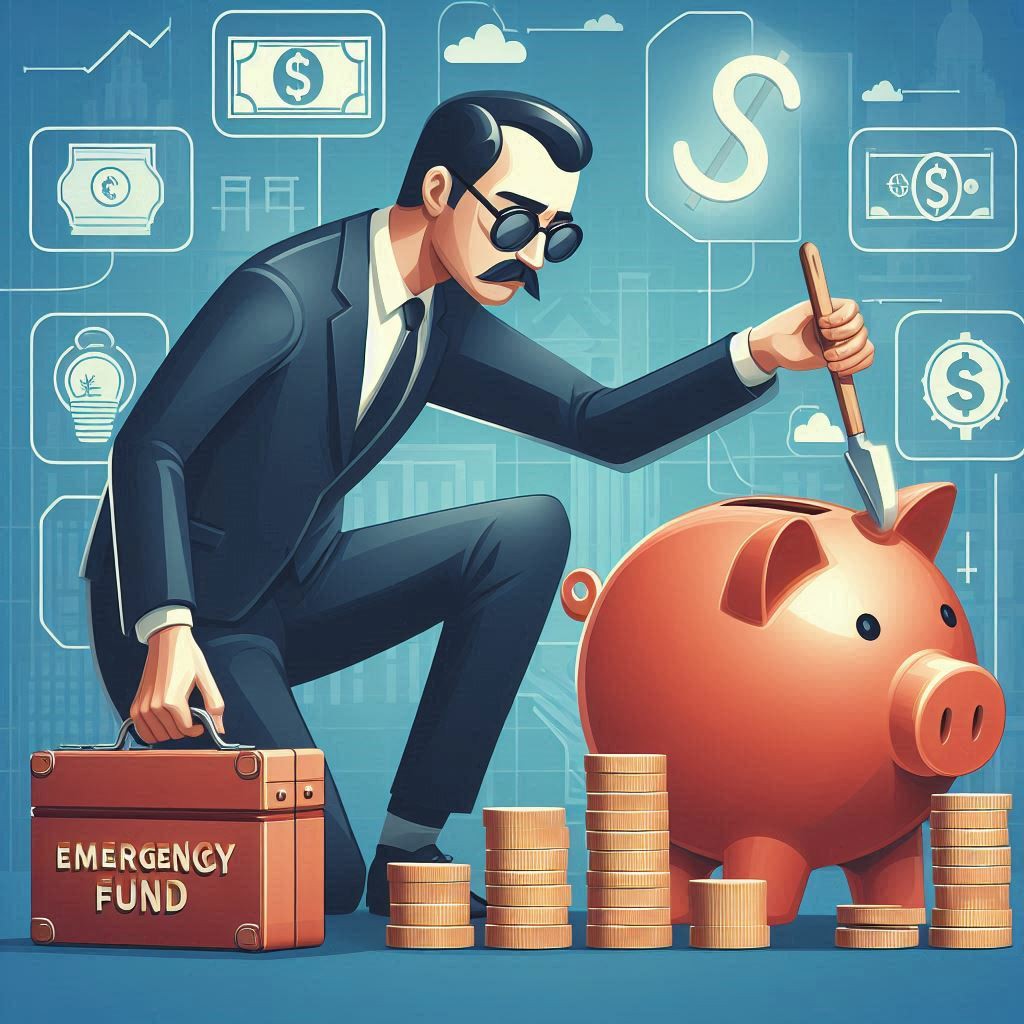This should be the very first step if you want to achieve financial freedom, and it’s a life-saving tip. The first thing you should do when you receive any income is allocate a small percentage to your emergency fund. How to Build an Emergency Fund is one of the most important questions you should resolve toward achieving financial stability and peace of mind.
An emergency fund is the cornerstone of any sound financial plan. It acts as your personal safety net, designed to cover unforeseen expenses and protect you from the stress that comes with financial crises. Whether it’s a sudden medical bill, an unexpected home repair, or losing your job, an emergency fund ensures that you’re not forced to rely on high-interest debt or make drastic financial decisions when life throws a curveball.
1. What Is an Emergency Fund?
An emergency fund is money set aside specifically for unexpected, urgent expenses. It’s not meant for day-to-day expenses or discretionary purchases. Instead, it’s there for those times when life hits you with something you didn’t see coming—a major car repair, a medical emergency, or even job loss. The primary goal of an emergency fund is to provide financial stability during challenging times.
So, what is an emergency fund? It’s a reserve of money that you save with the intention of using it in the future when something unexpected happens. Imagine you suddenly lose your job or face a medical emergency. You can tap into this fund without the stress of figuring out how to cover your expenses immediately. Essentially, it’s about preparing today for the uncertainties of tomorrow.
Why Is It Important? Emergencies are inevitable, and they often come with a hefty price tag. According to surveys, nearly 40% of Americans can’t cover a $400 emergency without borrowing money or selling something. This underscores the need for a financial buffer to protect yourself from going into debt when unexpected situations arise.
( Source – https://finance.yahoo.com/news/percentage-americans-unable-cover-400-133058811.html )
The Amount You Should Aim For
How much should you have in your emergency fund? Most financial experts recommend saving enough to cover 3 to 6 months of living expenses. This amount ensures that if you lose your job or experience a significant disruption to your income, you have the financial resources to get by without having to immediately find another source of income.
For instance, if your monthly expenses are $3,000, aim for an emergency fund of $9,000 to $18,000. This amount should give you the peace of mind that you can maintain your current standard of living even during tough times.

2. The Benefits of Having an Emergency Fund
Building and maintaining an emergency fund has several key benefits that can improve your overall financial well-being:
a) Financial Security:
An emergency fund provides you with a financial cushion that helps you feel secure, knowing that you have savings set aside for life’s surprises. Having an emergency fund can significantly reduce the anxiety and stress that come with unexpected financial burdens.
b) Avoiding High-Interest Debt:
Without an emergency fund, you may be forced to rely on credit cards or loans to cover unexpected expenses. These often come with high interest rates, which can compound the financial burden over time. By having an emergency fund, you can avoid falling into the trap of high-interest debt when emergencies arise.
c) Flexibility in Times of Crisis:
An emergency fund gives you the freedom to handle unexpected situations without making hasty financial decisions. If you lose your job, for example, you won’t be pressured into taking the first job offer that comes along. You can afford to take the time to find a job that’s right for you.
d) Peace of Mind:
One of the greatest benefits of an emergency fund is the peace of mind it provides. Knowing that you’re financially prepared for an emergency means you can focus on other areas of your life without the constant worry of how you’ll handle a financial crisis.
E) protect your dignity
Another key benefit of an emergency fund is that it helps protect your dignity. When a financial crisis hits, you won’t have to ask friends or family for help or rely on borrowing money from others. Having your own savings means you can handle the situation independently and avoid the embarrassment that sometimes comes with asking for assistance. In turn, this boosts your confidence and ensures you maintain control over your personal finances.

3. How to Build an Emergency Fund
3. How to Build an Emergency Fund
Building an emergency fund is a gradual process, but by sticking to a plan, you can establish a reliable financial buffer. Here’s how to do it:
a) Start by Setting a Target Amount
Determine how much you need based on your monthly expenses. A good rule of thumb is to aim for at least 3 to 6 months’ worth of essential expenses, such as rent/mortgage, utilities, groceries, insurance, and transportation. If your monthly expenses are $3,000, for example, your emergency fund should be somewhere between $9,000 and $18,000.
b) Save Gradually—Step by Step
You don’t need to build your emergency fund overnight. It’s perfectly fine to start small and build it up over time. Begin by setting aside a small percentage of your income—say 10% to 20%—each month. Over time, these small contributions will add up.
“So, how much should you build into your emergency fund? You should aim for an amount that would allow you to live without working for at least six months. This means covering all essential expenses like rent, food, bills, and medical care. Since this can be a large amount, the key is to build it up step by step. It could take months or even years, but the important thing is to start.”
c) Automate Your Savings
One of the easiest ways to ensure consistent contributions to your emergency fund is to automate the process. Set up automatic transfers from your main account to your emergency fund account each time you get paid. This way, you don’t have to think about it, and you won’t forget to make your contribution.
You can put in standing instructions to transfer money as soon as your salary hits your bank account. By doing this, you’ll ensure that the money is saved before you even have a chance to spend it elsewhere.
d) Find the Right Account
Where should you keep your emergency fund? Ideally, it should be easily accessible in case you need it on short notice, but not too easy to access so that you’re not tempted to dip into it for non-emergencies. So, open a separate bank account but do not get a debit card or enable mobile or internet banking for that account. If you do, you may never maintain your emergency fund. A high-yield savings account or money market account is typically a good option, as they offer liquidity while earning some interest.
It’s important to keep this money separate from your regular checking or savings account. Keeping it in a dedicated account will reduce the temptation to use it for non-emergency expenses and help you track your progress.
e) Prioritize It as a Long-Term Goal
Treat building your emergency fund like a financial priority. Once you’ve built the habit of contributing regularly, it will become second nature. Keep in mind that this fund is one of your most important financial safety nets, so even if it takes a while to fully fund it, remain committed.

4. How to Use Your Emergency Fund
Knowing when and how to use your emergency fund is just as important as building it. Remember, it’s meant to cover true emergencies, not everyday expenses or luxury purchases.
a) Use for Genuine Emergencies Only
Emergencies that qualify for using your fund include job loss, unexpected medical expenses, urgent home or car repairs, and other significant financial disruptions. If it’s not urgent or absolutely necessary, avoid using your emergency fund.
b) Replenish After Use
If you do need to tap into your emergency fund, make it a priority to replenish it as soon as you’re able. Start by resuming your regular contributions and, if possible, increase the amount you save until the fund is back at its target level.
c) Don’t Use for Non-Essentials
One of the most common mistakes people make is using their emergency fund for things that aren’t true emergencies. Vacations, gifts, or non-essential purchases shouldn’t come from your emergency fund. Discipline is key to ensuring the fund is there when you really need it.
d) Review and Adjust as Needed
As your financial situation changes, your emergency fund target may need to change as well. If your expenses increase, adjust your savings goal accordingly. It’s a good idea to review your emergency fund periodically to make sure it still aligns with your financial needs.
Conclusion
How to Build an Emergency Fund is one of the most important questions you should resolve toward achieving financial stability and peace of mind. While it may take time to save enough to cover 3 to 6 months’ worth of expenses, the benefits far outweigh the effort required. Start small, automate your savings, and remain disciplined, and soon enough, you’ll have a solid financial buffer in place. By following the strategies outlined in this guide, you’ll be well on your way to creating an emergency fund that can safeguard your future. Whether life throws a small challenge your way or a major financial hurdle, you’ll be ready, knowing that your emergency fund has your back.
Read at least the following golden posts – https://financementor.org/golden-tips/
If you need to clarify anything please contact me – https://financementor.org/contact/


